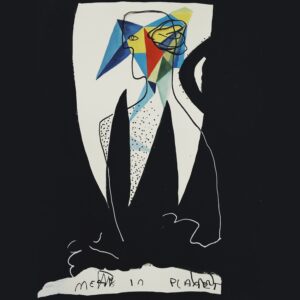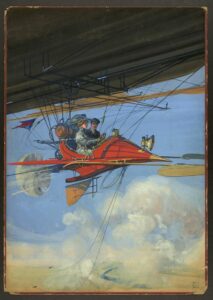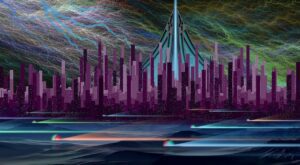Russian Futurism was a roaring flame of artistic and poetic movement that swept through Russia in the early 20th century.
It’s a world where traditional forms were dismantled, and new dynamic perceptions of the future took hold.
We’ll jump into the heart of this avant-garde wave, exploring its bold creators and the revolutionary impact they had on art.
Get ready to discover how Russian Futurism reshaped the cultural landscape and continues to inspire artists today.
Origins Of Russian Futurism
Russian Futurism emerged at the beginning of the 20th century, deeply rooted in the industrialization and social changes that were sweeping across Europe.
Unlike Italian Futurism which celebrated technology and modernity, Russian artists focused on exploring new forms of creativity through a unique cultural lens.
They sought to forge a distinct path, one that would break away from the influence of Western Europe and establish an avant-garde narrative deeply embedded in the Russian spirit.
Key Figures And Early Influences
The trailblazers of Russian Futurism are often celebrated for their bold rejection of classical artistry.
David Burliuk, known as the father of Russian Futurism, Velimir Khlebnikov, a poet and playwright, and painters like Kazimir Malevich and Natalia Goncharova pushed boundaries with their controversial ideas and creations.
Works such as Malevich’s Black Square and Goncharova’s The Cyclist encapsulated the movement’s radical break from traditional aesthetics.
Literature And Manifestos
In literature, the movement was heralded by the publication of the manifesto A Slap in the Face of Public Taste in 1912.
This publication called for:
- A rejection of classical literary canons,
- An embrace of linguistic experimentation,
- The creation of a new artistic language that resonated with the future.
This manifesto and subsequent works fueled the creative explosion that became synonymous with Russian Futurism.
Literature was no longer about refined elegance; it was a vehicle for disruption and an instrument for shaping a new cultural identity.
Combining these diverse artistic expressions and cultural innovations, Russian Futurism laid the groundwork for a profound transformation within the art world.
The movement’s influence extended beyond the canvases and pages to reach the burgeoning world of film, where its ethos would shape the future of cinematic art through a new visual language that embraced montage and other filmic techniques to challenge and captivate audiences.
Key Features And Principles
Russian Futurism was marked by a number of distinctive features and principles that set it apart from other art movements:
- Reject traditional forms – Artists and poets under the umbrella of Russian Futurism were known for their outright rejection of established artistic and literary traditions. They sought to carve out a novel narrative that was unshackled from the influences of their Western European counterparts.
- Embrace of industrialization – There was an overt fascination with the machine age. The futurists incorporated images of modern technology and industrial landscapes to symbolize the energetic pace of contemporary life.
Within their body of work, the Futurists championed a variety of creative principles:
- Innovative use of language – In literature, words were freed from the constraints of syntax, leading to the creation of a new poetic language that was bold and fragmented.
- Dynamic composition – In visual arts, artists like Kazimir Malevich and Natalia Goncharova utilized vibrant colors and geometric shapes to convey movement and to disrupt the static nature of the canvas.
also, the movement was keen on exploring the synergy between different forms of art.
The synthesis of text and visual elements resulted in powerful expressions that extended well into the realm of performance:
- Multi-disciplinary collaboration – Russian Futurism saw the merging of visual arts with drama, poetry, and music, creating a multisensory experience. Works like Victory Over the Sun showcased this multi-faceted approach by integrating costumes, backdrops, and music with avant-garde poetry.
- Revolutionary narratives – Storytelling often revolved around themes of revolution and change, mirroring the political climate of the time.
In film, the Russian Futurists’ influence led to the adoption of new cinematic techniques that were geared towards capturing the essence of movement and modernity.

Directors such as Dziga Vertov were instrumental in this aspect, utilizing experimental montage and other methods to reflect the movement’s ideology on the silver screen, with films like Man with a Movie Camera being prime examples of this approach.
Through these bold pursuits, Russian Futurism left an indelible mark that’s still evident in contemporary art practices, ensuring the movement’s ideas and aesthetics resonate even today.
Leading Figures Of Russian Futurism
When we jump into Russian Futurism, it’s impossible to overlook the titans of the movement.
Artists and poets like Vladimir Mayakovsky, Velimir Khlebnikov, and David Burliuk were pivotal in forging this innovative path.
Their works, encapsulating the tumultuous energy of the era, became the bedrock of Russian avant-garde culture.
Vladimir Mayakovsky challenged the literary world with his expressive, and often controversial, poetry and playwriting.
His contribution to the art world extended to graphic design, where his powerful typographic layouts left an indelible mark.
Mystery-Bouffe, a play written by Mayakovsky, exemplifies the raw spirit of Russian Futurism by merging political ideology with performance art.
Velimir Khlebnikov, known for his unconventional linguistic experiments, offered a unique voice that resonated with the core principles of Russian Futurism.
His exploration into the realm of zaum – a transrational language – was both thought-provoking and quintessential to the movement.
The artistic prowess of David Burliuk fueled Russian Futurism with his multifaceted endeavors that enveloped painting, illustration, and poetry.
Burliuk’s vibrant paintings, stirred by Cubo-Futurist influences, were complemented by his persuasive manifestos advocating for a break from established norms.
The powerhouses of Russian Futurism didn’t stop at individual creation, they were also adept in collaborative work –
- Natalia Goncharova and Mikhail Larionov, prominent painters and designers, directly influenced the Moscow avant-garde scene with their theatrical designs and Rayonist paintings.
- Collaborations amongst Futurists catalyzed a synergy that transcended the limitations of single-medium expressions. This cross-disciplinary approach enriched the entire movement, allowing a fusion of ideas and mediums that was essential for the evolution of Russian Futurism.
Each figure brought forth a unique interpretation of the aesthetic and cultural values of the time, defining and advancing Russian Futurism through their prolific output and innovative techniques.
Their legacies continue to inspire modern-day artists and filmmakers, drawing upon the movement’s revolutionary energy to challenge contemporary narratives and visual styles.
Impact On Visual Arts
Russian Futurism not only revolutionized the written word but also had a profound influence on the visual arts.
Artists embraced dynamic compositions, geometric shapes, and a vibrant palette to capture the essence of movement and the industrial age.
Our exploration into this impactful genre reveals how it redefined artistic expression in paintings, stage designs, and beyond.
The movement’s bold approach to art encouraged a departure from static imagery towards the depiction of motion.
Works like Man at the Crossroads depicted humanity intertwined with technology, pointing to a future where progress and innovation were
Such pieces became cornerstones that challenged viewers to perceive the world through the prism of constant change and evolution.
- Russian Futurists eagerly incorporated various materials and techniques – They produced a heterogeneous mix of textures and forms – This resulted in an effervescent creativity that transcended traditional media boundaries.
Our examination of Russian Futurism’s impact on visual arts unveils its integral role in propelling the avant-garde of the early 20th century.
The contributions of the movement’s artists laid the groundwork for subsequent modernist trends and continue to inspire contemporary creators striving to depict their vision of the world’s incessant dynamism.
Influence On Literature And Poetry
In the sphere of literature, Russian Futurism shattered the linguistic norms and unleashed a liberation of vernacular previously unseen.
Vladimir Mayakovsky and Velimir Khlebnikov, were at the forefront, concocting neologisms and brazenly deconstructing the syntax.
These unwavering efforts gave rise to poems that resonated with the whir of machines and the pace of modern life.
Inspired by the movement’s aesthetic, poets embarked on a quest for novel literary techniques that mirrored the tumult of an evolving society:
- Utilization of zaum – a transrational language crafted to transcend logical understanding and communicate on an emotional plane,
- Orchestrating typographical layouts to enhance the visual aspect of poetry and capture the essence of their industrial muse,
- Introducing unconventional narrative structures that mirrored the fragmented reality of the early 20th century.
Mayakovsky’s The Backbone Flute and Mystery-Bouffe challenged readers with their radical content and form, reflecting the Futurists’ desire to revolutionize.
In parallel, Khlebnikov’s Zangezi introduced a chorus of voices, propelling literary narratives into realms that evoked the orchestration of cinema.
Their works were not only read but performed, turning poetry into public spectacles akin to the currents in performance art.
The impact of Russian Futurism on literature and poetry did not ebb with the close of an era; it propelled Russian storytelling into a domain seasoned with innovation and dramatic expressiveness.

It’s in these transformative approaches to language and narrative structure that the echoes of the movement’s zeal can still be discerned in contemporary literature.
Legacy And Contemporary Inspiration
The ricochet of Russian Futurism echoes vibrantly in contemporary art and film.
Our creative landscape is decorated with elements inspired by the bold visual language and revolutionary ethos of this movement.
The seeds planted by its pioneers have blossomed into a multitude of forms – from abstract expressionism to the raw energy of punk rock aesthetics.
Futurism’s emphasis on motion and industrial motifs found a fresh canvas in the digital realm.
Artists of the 21st century draw on the foundations laid by Russian Futurism, infusing technology with art to create interactive installations and virtual experiences.
In film, directors harness the dynamic techniques of the Futurists to depict the ever-accelerating pace of our world.
- Inspirations in Modern Art and Design – * Abstract expressionists owe a debt to Russian Futurist techniques * digital artists create multimedia installations influenced by Futurist dynamics * Punk and alternative fashion echo the movement’s rebellious spirit,
- Cinematic Techniques Borrowed from Russian Futurism – * Rapid editing & visual effects that create a sense of movement * Nonlinear storytelling in avant-garde cinema * Use of synthetic and industrial sounds to enhance narratives.
These pillars of Russian Futurism extend into the approaches we see in advertising, branding, and even web design.
The movement’s penchant for novelty and its forward-looking perspective are as relevant now as they were a century ago, driving the innovation that keeps visual culture perpetually fresh and exciting.
We see its legacy not only in the stylized graphics but also in the core concept that the essence of art is to not only mirror the present but to mold the future.
What Is Russian Futurism In Art – Wrap Up
We’ve seen how Russian Futurism forged a path of innovation and rebellion, reshaping the cultural landscape of the 20th century.
This movement’s bold strides in art, literature, and film continue to resonate, influencing modern creators who push the boundaries of expression.
Our journey through the vibrant world of Russian Futurism has revealed a legacy that goes beyond the canvas and the page, infiltrating the digital age with a spirit that’s as relevant today as it was a century ago.
As we embrace the future, we carry with us the indelible mark of Russian Futurism’s quest for a new artistic language—one that challenges, inspires, and transforms.

Frequently Asked Questions
What Is Russian Futurism?
Russian Futurism was an artistic and poetic movement that originated in Russia in the early 20th century.
It aimed to establish a unique avant-garde narrative that represented a departure from Western European influences and embraced the Russian spirit.
Who Wrote The Manifesto ‘a Slap In The Face Of Public Taste’ And What Was Its Purpose?
The manifesto “A Slap in the Face of Public Taste” was published in 1912 by Russian Futurists to call for the rejection of classical literary canons and to advocate for the creation of a new, innovative artistic language.
What Impact Did Russian Futurism Have On Cinema?
Russian Futurism influenced the world of film by introducing new visual techniques that shaped the future of cinematic art, contributing to dynamic storytelling and innovative cinematography.
Who Were The Key Figures In Russian Futurism?
Key figures in Russian Futurism included Vladimir Mayakovsky, Velimir Khlebnikov, and David Burliuk, among others.
They were instrumental in propelling the movement through their artistic and literary contributions.
How Did Russian Futurism Affect Contemporary Art And Filmmaking?
Russian Futurism’s influence on contemporary art and filmmaking is evident through its revolutionary ethos, focus on motion, and industrial motifs.
Its techniques and aesthetics continue to inspire abstract expressionism, digital art, and dynamic film direction.
In What Ways Has Russian Futurism Influenced Modern Visual Culture, Such As Advertising And Web Design?
Russian Futurism has extended its reach into modern visual culture, including advertising and web design, by driving innovation with its novelty, forward-looking perspective, and emphasis on shaping the future of visual expression.


